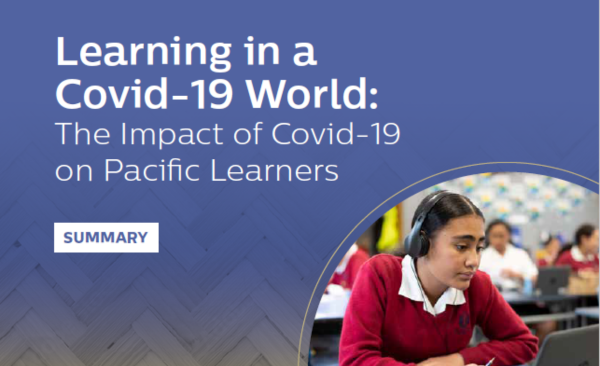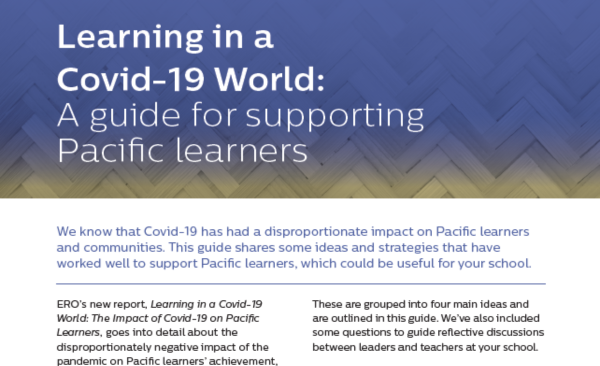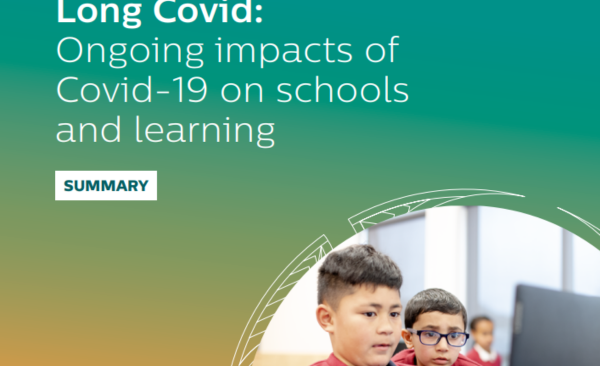The impacts of Covid-19 have been widespread and numerous. ERO has been tracking these impacts since the first lockdown. This section sets out ways in which Pacific learners were impacted before the Delta outbreak. Like all learners, the first year of the pandemic impacted on Pacific learners’ learning, wellbeing, and engagement. Adults, families, teachers, and friends provided additional support to help learners to continue to engage in their education.
This section sets out what we know about the impact of the first year of Covid-19 (April 2020 to July 2021) on Pacific learners’:
- learning, including schoolwork, progress, and keeping up with learning
- wellbeing, including anxiety about Covid-19, feelings about the year ahead, and sense of happiness
- engagement, including enjoyment of learning and attendance
- support, including support from adults, families, teachers, and friends.
These findings are based on surveys conducted at three time points. ‘Agreement’ was identified as those who responded with either ‘Strongly Agree’ or ‘Agree’ to the questions. ‘Don’t know’ responses were removed from the totals. Percentages are rounded to the nearest whole number.
Pacific learner responses are examined alongside overall general population learner responses as a point of reference. Pacific learners are included in the general population responses.
Some questions asked in early 2020 are not identical to those in late 2020 and mid 2021 but are included together on graphs as the closest questions to address some concepts across the course of the pandemic.
Impact on learning
Like all learners, Pacific learners have faced challenges with their learning due to many Covid‑19 related disruptions.
Struggling with schoolwork
In mid‑2021, only half of Pacific learners felt they were coping with their schoolwork; this was similar to both early and late 2020 (see Figure 1).
Figure 1: Percentage of learners who agreed or strongly agreed that they were coping with their schoolwork
Only half of learners felt they were making good progress
Only about half of Pacific learners were positive that their learning progress had been good in the term they completed the survey. Pacific learners in late 2020 were six percentage points more positive than the general population and in mid-2021, they were four percentage points more positive (see Figure 2).
“I need to try and play less and work more.” - Year 8 Pacific learner
“Keep working hard and complete the learning you have to complete to succeed.” - Year 12 Pacific learner
Figure 2: Percentage of learners who agreed or strongly agreed that their learning progress had been good ‘this term’
More Pacific learners felt they needed to catch up on their learning
In June and July 2021, almost half (47 percent) of Pacific learners indicated they needed to catch up on their learning. This was substantially more (15 percentage points) than the proportion of learners in the general population (32 percent) who responded the same way (see Figure 3).
“I feel that I am behind on my work and I find it a little bit hard with time management here at home. I hope to return to school real soon to catch up.” - Year 13 Pacific learner from Auckland
Figure 3: Percentage of learners who agreed or strongly agreed that they needed to catch up on their learning (mid-2021)
Impact on wellbeing
Covid-19 impacted on Pacific learners’ wellbeing, including anxiety about Covid-19, feeling positive about the year ahead, and their sense of happiness.
Learners remained anxious about Covid-19
In addition to anxiety about learning and feeling like they needed to catch up on their learning, Pacific learners were anxious about Covid-19. The extent to which learners have been feeling safe from Covid-19 has changed over time. In early 2020, learners were in lockdown and learning from home. At this time, most learners reported feeling safe from Covid-19, likely because their chance of exposure was limited by being at home. In late 2020, learners were feeling less safe from Covid-19, reflecting the increased risk of being out of a lockdown situation. In mid‑2021, more learners were feeling safe, reflecting the reduced risk of catching Covid-19 at a time of no recorded community transmission. Pacific learners responded in very similar ways to learners in the general population (see Figure 4).
“I don't like that we are still going to school. Because we should be at home so Covid doesn’t come to school. I really love school but still I care about our safety.” - Year 8 Pacific learner
Figure 4: Percentage of learners who agreed or strongly agreed that they were feeling safe from Covid-19
Only half of Pacific learners felt positive about the year ahead
In late 2020, we asked learners how positive they were feeling about the rest of the year and less than half of Pacific learners were feeling positive about the rest of the year. This was at a similar level (four percentage points more) to the learners in the general population (see Figure 5).
Figure 5: Percentage of learners who agreed or strongly agreed that they were feeling positive about the rest of the year (late 2020)
Most Pacific learners felt happy overall
Like the general population, over half of Pacific learners felt happy all of the time or most of the time in mid‑2021. More Pacific learners felt happy all of the time (six percentage points more) than learners in the general population (see Figure 6).
Figure 6: Percentages of learners who reported that they felt happy (mid-2021)
Impact on engagement with education
Engagement in education has been impacted by Covid-19, including attendance and enjoyment of learning.
Pacific learners were more positive about enjoying learning
Well over half of Pacific learners reported that they were enjoying their learning, and this had increased slightly over time. Pacific learners were enjoying their learning much more than learners in the general population across time. For example, Pacific learners were enjoying their learning 13 percentage points more in late 2020 and 18 percentage points more in mid-2021 compared to the general population. Pacific learners were also enjoying their learning at home more (seven percentage points) than the general population in early 2020 (see Figure 7).
Figure 7: Percentage of learners who agreed or strongly agreed that they were enjoying their learning
Schools were concerned about engagement
Despite many learners enjoying their learning, schools had concerns about engagement. Nearly half of the schools we talked to in late 2020 had ongoing concerns about attendance. This was more pronounced in low (deciles 1 to 3), and mid (deciles 4 to 7) decile schools compared to high decile schools (deciles 8 to 10). Pacific learners are more likely to be enrolled in lower decile schools, meaning they may be more likely to be experiencing challenges with attendance (see Figure 8).
“2020 has been the year where all hopes for productivity have relinquished. Covid-19 has stressed out everyone and held people back from reaching potential.” - Year 13 Pacific learner from Auckland
“Covid has stuffed a lot of things up. Many of us are tempted to drop out and just work.” - Year 13 Pacific learner from Auckland
Figure 8: Percentage of schools who were concerned about attendance in late 2020 by decile
Pacific learners’ attendance was impacted
Attendance is critical for achievement, particularly at NCEA level. There is strong evidence[4] that absenteeism has negative impacts on qualification attainment.
Following the Auckland lockdown in August 2020, Pacific learners in Auckland were less likely to return to the classroom. The Ministry of Education found[5] that 22 percent of Pacific learners in Auckland did not return to school the week after lockdown, compared to only 10 percent of the general population of learners in Auckland (12 percentage points higher for Pacific learners), (see Figure 9).
Although Pacific learners were more likely to report feeling safe from Covid-19 during this period, we found that a contributing factor to attendance was health‑related anxiety, particularly for those in multi‑generational households with more vulnerable elderly family members.
“Due to Covid-19 I have not been motivated to come to school and due to that I have been missing out a lot on school.” - Year 13 Pacific learner from Auckland
Figure 9: Percentage of Auckland learners who had not returned to school the week after August 2020 Auckland lockdown
The Ministry of Education[6] also found that one month on from the Auckland lockdown in August 2020, Pacific learners in Auckland continued to show reduced attendance. The proportion of Pacific learners who were chronically absent (attending less than 70 percent of the time) that month increased 13 percentage points from 18 percent in 2019 to 31 percent in 2020 (see Figure 10).
Figure 10: Percentage of Auckland Pacific learners’ who were chronically absent in month after the 2020 Auckland lockdown compared to the same month in 2019 (pre Covid-19)
Support for Pacific learners
Schools and families provided a significant amount support to Pacific learners throughout the disruptions.
Pacific learners often had an adult they could talk to
Pacific learners, like all learners, generally felt supported by the adults in their lives. Throughout the first year of Covid-19 most learners felt there was an adult they could talk to if they were worried about something. In early 2020, this was two percentage points more for Pacific learners, in late 2020 this was seven percentage points more, and in mid-2021 this was five percentage points more than the general population (see Figure 11).
Figure 11: Percentage of learners who agreed or strongly agreed that they were feeling supported by adults
Pacific families also supported learning
Pacific learners, like learners in the general population, felt there was someone at home who could help them with their learning. This feeling was seven percentage points higher for Pacific learners in early 2020 and five percentage points higher in late 2020 (see Figure 12).
“I would like to say a huge thanks to my Mum and Dad for helping me with my schoolwork.” - Year 8 Pacific learner
“When I need help, there is a person there to help me!” - Year 6 Pacific learner
“I really focus on my assessment because my parents are supporting me with doing my assessment.” - Year 12 Pacific learner
Figure 12: Percentage of learners who agreed or strongly agreed that they had people to help with their learning at home
Many Pacific learners felt that there was someone at home who had become more interested in their learning in late 2020. This was higher for Pacific learners (11 percentage points more) than for learners in the general population (see Figure 13). This indicated that Pacific learners experienced a larger increase in support and interest in the term following the first national lockdown and during the term of the Auckland lockdown. ERO has previously reported[7] that schools saw greater family involvement in children’s learning as a key positive of the 2020 lockdown.
Figure 13: Percentage of learners who agreed or strongly agreed that parents or adults had become more interested in learning (late 2020)
Friends also proved a source of support to Pacific learners
Pacific learners, like most learners in the general population, have felt connected to their friends across the course of the pandemic. In early 2020, 69 percent of Pacific learners felt they had a friend they could talk to while they were learning from home. This was three percentage points less than for the general population of learners (see Figure 14).
Learners have also continued to feel connected to friends in the times following lockdowns (see Figure 15).
“l prefer learning from school with teachers and friends.” - Year 5 Pacific learner
“I would like to say that I enjoy staying in school because I get to talk to my best friends.” -Year 5 Pacific learner
Figure 14: Percentage of learners who agreed or strongly agreed that they had friends to talk to while learning form home (early 2020)
Figure 15: Percentage of learners who agreed or strongly agreed that they felt connected to their friends in the past week
Pacific learners have felt more supported by their teachers
Pacific learners were much more likely (21 percentage points more), than learners in the general population, to say that they got extra help from their teachers when they returned to school after lockdown and that they had an adult at school who cared for them (see Figure 16 and Figure 17).
“After lockdown, I got lots of support from my teachers and during lockdown too. This really helped me get back on track with my learning.” - Year 6 Pacific learner
“The teachers are helping me with a lot of things.” - Year 6 Pacific learner
Figure 16: Percentage of learners who agreed or strongly agreed that they got extra help from their teachers (mid-2020)
Figure 17: Percentage of learners who agreed or strongly agreed that they had an adult at school who really cared about them
Pacific learners were between 10 and 15 percentage points more positive that their teachers cared about both their wellbeing and learning than learners in the general population (see Figures 18 and 19).
“I would like to say a big thanks to all my teachers for their care and support with my learning and wellbeing.” - Year 8 Pacific learner
Figure 18: Percentage of learners who agreed or strongly agreed that they felt their teachers cared about their learning
Figure 19: Percentage of learners who agreed or strongly agreed that they felt their teachers cared about their wellbeing
Conclusion
Prior to the Delta outbreak, only half of Pacific learners were coping with their schoolwork and felt their learning progress has been good. Pacific learners felt supported by their teachers, the adults in their lives, their families, and their friends. However, more Pacific learners felt they needed to catch up on their learning compared to learners in the general population.
Pacific learners were feeling safe from Covid-19, were feeling happy, and were still enjoying their learning but there were signs of Pacific learners disengaging from school with decreased attendance, especially following lockdown.




























